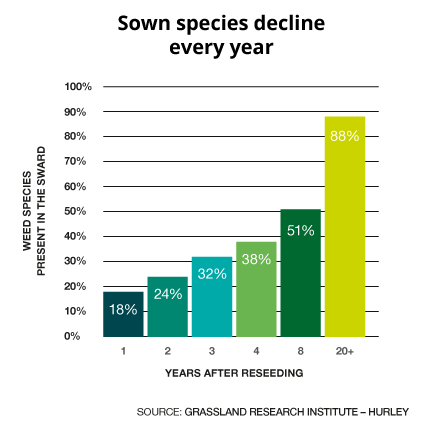CALL SEED ON: 01769 576232
Quality Grass For Sheep
All UK sheep farmers have one thing in common, the need to produce grass to eat all year round - in spring and summer by grazing livestock and in winter as silage. In sheep and lamb production where margins are incredibly tight, high quality grass can be the key to profitability, so keeping a constant supply in front of livestock makes sound financial sense.
The Need To Reseed
A reseeding rate of just 10% is enough to prevent a decline in grass productivity while upping it to 15% will start to deliver real gains. Fields that are not reseeded will quickly become overrun with weed species with little or no nutritional value. Not only does grass yield decline as weed species take over, digestibility, feed value and animal performance will also diminish.


Reducing the cost of production can help make a significant improvement to your profitability. Grazed grass has always been recognised as one the most economical ways to feed livestock but there are also some great forage crop options to help supplement feeding.
Introducing a forage crop is very easy and can bring some real benefits:
- Help reduce your production costs.
- By selecting the correct crops and varieties, livestock farmers can maximise their home grown feed and enhance profitability.
- Low input costs per acre.
- Versatile – they can be used to fill summer grazing gaps, extend autumn grazing or
support out wintering systems. - Excellent break crop between grass, reducing weed and pest issues prior to reseeding to a more productive new ley.
- Mixed forage diets help increase intakes and ensure optimum rumen stability, improved feed utilisation and animal performance.


| Crop | Average sowing rate kg/acre |
Sowing date guide | Utilisation period | Average fresh yield tonnes/ha |
Average dry matter yield tonnes/ha | Dry matter % |
Crude protein % |
D-value | ME MJ/kg DM | |
| Broadcast | Direct drill | |||||||||
| Forage Rape |
4 | 2.5 | May-end Aug | July-Dec | 24-35 | 3.5-4 | 11-12 | 19-20 | 65D | 10-11 |
| Kale | 3 | 1.5-2 | April-early July |
Sept-Mar | 60-65 | 8-10 | 14-16 | 16-17 | 68D | 10-11 |
| Stubble Turnips |
3 | 2 | Mid April end Aug |
June-Dec | 38-45 | 3.5-5 | 8-9 | 17-18 | 68-70D | 11 |
| Swedes | 2 | 1 | April-June | Oct-Mar | 70-90 | 7-10 | 10-13 | 10-11 | 82D | 12.8-13.1 |
| Main Crop Turnip |
2 | 1- 1.5 | May-July | Oct-Feb | 60-70 | 5.5-6 | 8-10 | 15-17 | 80D | 10-11 |
| Forage Rye | 75 | 75 | Sept-Oct | Feb onwards |
20-24 | 5-6 | 25 | 11-12 | 67D | 10 |


